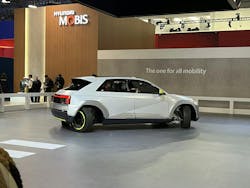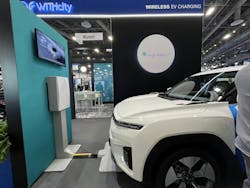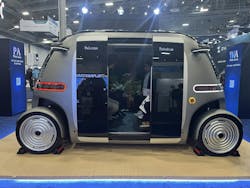From electric and autonomous vehicles to advancements in LiDAR, software (including AI), and charging solutions, the automotive industry has once again been seen as a ‘show-within-a-show’ at CES 2024.
CES 2024 took place Jan. 9 - 12 in Las Vegas and brought in over 4,300 exhibitors and 135,000 attendees from around the globe.
Not only do many automakers and automotive service companies use this show to display their latest concept vehicles and product launches, but many industry professionals take the stage to share what is trending in the industry and what challenges they are facing.
The push for electric vehicles
It is estimated that 130 new EV models will launch over the next two to three years in the U.S. alone and that OEM’s have been spending trillions of dollars to build EV factories and battery plants.
While walking the show floor, it was evident to see automakers are indeed amping up their game.
Notable EV concepts on display:
Hyundai Mobis: MOBION – Each wheel is individually controlled to allow the vehicle to move sideways and diagonally, as well as pivot turn.
Mercedes-Benz: All-electric G-Class – Features four electric motors close to each wheel that are individually controllable, allowing the EV SUV to turn 360 degrees.
VinFast: VF Wild – This electric mid-size pickup truck features a panoramic glass roof, digital side mirrors, and an expandable bed.
Honda: Saloon and Space-Hub – The first models of the company’s new ‘0 series’ EV lineup. The Saloon is more of a low-riding sports car, whereas the Space-Hub is a spacious minivan with center-facing bench seats.
Kia: Platform Beyond Vehicle (PBV) models – Five models were unveiled: Three PV5 derivatives, PV7, and PV1. With a single chassis design and a fixed cab, a variety of upper bodies can be connected to the base vehicle to enable a modular solution for businesses and individuals.
Sony Honda Mobility: AFEELA - Continuing to advance from last year's concept, the prototype features two 180 kW motors, 3-D mapping technology, and a video-game-like feel.
However, as EVs keep rolling out, many consumers still seem reluctant to buy them, panelists share.
According to Amiya Aly, president of AutoFin Consulting, there are three main contributing factors to this:
- Affordability
- Range anxiety
- Charging infrastructure
“We got a long way to go [for EVs to reach peak]; we got a lot of challenges in front of us,” said Brendan Jones, president and CEO of Blink Charging. “But all those challenges have very viable solutions if we collaborate and work together.”
“Tesla alone sold 1.3 million electric vehicles,” Jones noted. “That type of volume is astronomical [and shows] this industry is on the move. This industry has faced challenges, and it has moved forward. It will face more challenges, and it will move forward.”
When it comes to affordability, the battery itself plays a large role, accounting for up to 40 percent of the total cost of the EV.
And as EVs continue to advance, automakers are demanding higher power requirements and extended range which is putting pressure on battery manufacturers to develop safe, secure, and scalable batteries for the market.
To help cut down on battery costs, companies such as Panasonic Energy are utilizing AI in their manufacturing processes.
“We need to be able to supply products to the end consumer that they can afford,” said Justin Herman, vice president and chief information officer at Panasonic Energy North America. “AI is playing a larger and larger role in this.”
Regarding range anxiety, many people think they need a range of 500 miles but in reality, many people don’t actually need that, Aly stated. Especially if their daily commute is mostly to and from work or to and from the store, etc.
As for the EV charging infrastructure, Blink Charging reported that if the U.S. gets to a 35 percent battery electric vehicle penetration rate by 2035, we’re going to need 30 million chargers.
“Even if it’s 30 percent, more chargers are needed than the production capacity to meet the demand,” said Mike Battaglia, COO of Blink Charging.
On the show floor, there were many EV charging solutions, including new direct current (DC) fast chargers making their debut at CES.
Notable EV chargers on display:
TOPDON: BoostQ DC Fast Charger– Features a 15” LCD high-contrast touchscreen and a maximum power output of 240 kW.
Autel: MaxiCharger DC HiPower – Features a maximum power output of 640 kW and can charge one vehicle at a maximum of 480 kW, or two vehicles synchronously at 320 kW each.
WiTricity: Halo – This wireless charging pad charges vehicles from low-profile sports cars to SUVs and trucks.
The future of self-driving cars
Although self-driving cars were pretty scarce on the show floor this year at CES, that doesn’t mean automakers lost interest.
Years ago, when the idea that autonomous vehicles could roam the streets, many automakers jumped at the possibility perhaps a bit too fast and have since realized it’s going to take more time.
“We went immediately to full autonomy and tried to deliver but the industry finally realized that we can’t,” said Aaron Jefferson, vice president of product at Luminar Technologies. “So now we're seeing the pullback to L2 and L3 because we need to crawl before we walk and run.”
However, depending on where you live, you may have already experienced it.
“If you go to the right places like San Francisco, Phoenix, China, and some other places, you can experience self-driving taxis and it’s pretty exciting,” said Johann Jungwirth, senior vice president of autonomous vehicle at Mobileye.
In a panel discussion, industry professionals agreed the technology is here and will help make roads safer, however, to achieve success there not only needs to be more consumer trust, knowledge, and willingness to adapt but also more validation, testing, and regulations on their end as well.
The panelists all seemed very optimistic, all agreeing that it will happen one day. That's a guarantee.
For an update on autonomous commercial vehicles, please see Fleet Maintenance's, our sister publication, show coverage here.
Other notable automotive product launches from CES:
XPENG AEROHT: eVTOL Flying Car - This supercar is ready to take flight in a matter of seconds. It seamlessly unfolds its flying components for short-distance, low-altitude travel.
RoboSense: M2 and M3 LiDAR sensors - M2 leverages proprietary 2-D scanning technology to deliver mid-range LiDAR (200m), while the M3 can detect long-distance objects (300m) up to 75 mph.



